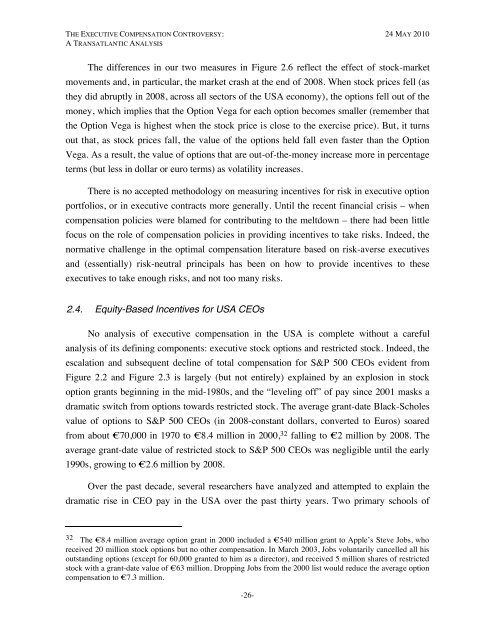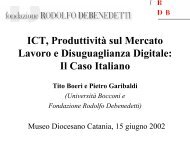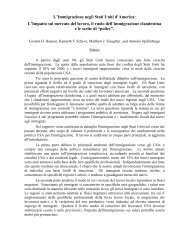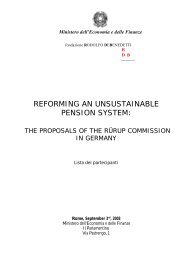The Executive Compensation Controversy - Fondazione Rodolfo ...
The Executive Compensation Controversy - Fondazione Rodolfo ...
The Executive Compensation Controversy - Fondazione Rodolfo ...
You also want an ePaper? Increase the reach of your titles
YUMPU automatically turns print PDFs into web optimized ePapers that Google loves.
THE EXECUTIVE COMPENSATION CONTROVERSY: 24 MAY 2010A TRANSATLANTIC ANALYSIS<strong>The</strong> differences in our two measures in Figure 2.6 reflect the effect of stock-marketmovements and, in particular, the market crash at the end of 2008. When stock prices fell (asthey did abruptly in 2008, across all sectors of the USA economy), the options fell out of themoney, which implies that the Option Vega for each option becomes smaller (remember thatthe Option Vega is highest when the stock price is close to the exercise price). But, it turnsout that, as stock prices fall, the value of the options held fall even faster than the OptionVega. As a result, the value of options that are out-of-the-money increase more in percentageterms (but less in dollar or euro terms) as volatility increases.<strong>The</strong>re is no accepted methodology on measuring incentives for risk in executive optionportfolios, or in executive contracts more generally. Until the recent financial crisis – whencompensation policies were blamed for contributing to the meltdown – there had been littlefocus on the role of compensation policies in providing incentives to take risks. Indeed, thenormative challenge in the optimal compensation literature based on risk-averse executivesand (essentially) risk-neutral principals has been on how to provide incentives to theseexecutives to take enough risks, and not too many risks.2.4. Equity-Based Incentives for USA CEOsNo analysis of executive compensation in the USA is complete without a carefulanalysis of its defining components: executive stock options and restricted stock. Indeed, theescalation and subsequent decline of total compensation for S&P 500 CEOs evident fromFigure 2.2 and Figure 2.3 is largely (but not entirely) explained by an explosion in stockoption grants beginning in the mid-1980s, and the “leveling off” of pay since 2001 masks adramatic switch from options towards restricted stock. <strong>The</strong> average grant-date Black-Scholesvalue of options to S&P 500 CEOs (in 2008-constant dollars, converted to Euros) soaredfrom about €70,000 in 1970 to €8.4 million in 2000, 32 falling to €2 million by 2008. <strong>The</strong>average grant-date value of restricted stock to S&P 500 CEOs was negligible until the early1990s, growing to €2.6 million by 2008.Over the past decade, several researchers have analyzed and attempted to explain thedramatic rise in CEO pay in the USA over the past thirty years. Two primary schools of32 <strong>The</strong> €8.4 million average option grant in 2000 included a €540 million grant to Apple’s Steve Jobs, whoreceived 20 million stock options but no other compensation. In March 2003, Jobs voluntarily cancelled all hisoutstanding options (except for 60,000 granted to him as a director), and received 5 million shares of restrictedstock with a grant-date value of €63 million. Dropping Jobs from the 2000 list would reduce the average optioncompensation to €7.3 million.-26-









